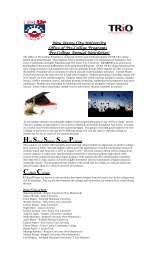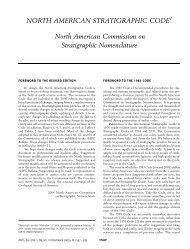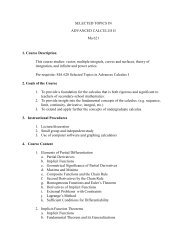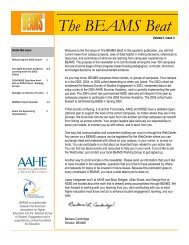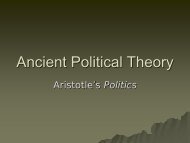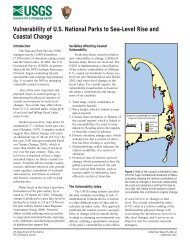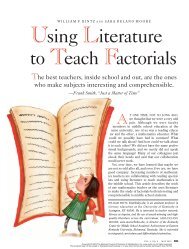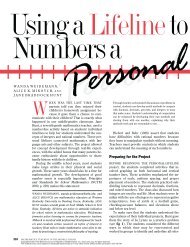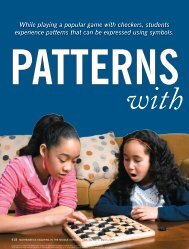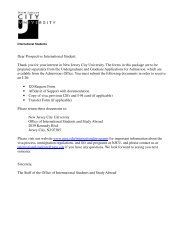Constructing complexity for differentiated learning.
Constructing complexity for differentiated learning.
Constructing complexity for differentiated learning.
You also want an ePaper? Increase the reach of your titles
YUMPU automatically turns print PDFs into web optimized ePapers that Google loves.
offer students opportunities to draw<br />
on their past experiences, use significant<br />
mathematics, and understand<br />
and make connections across mathematical<br />
ideas (Carpenter et al. 1997;<br />
NCTM 2000).<br />
The degree to which the tasks are<br />
respectful <strong>for</strong> individual students and<br />
groups of students depends on the<br />
adjustments made <strong>for</strong> student readiness.<br />
One key principle of a <strong>differentiated</strong><br />
classroom is that students have a right<br />
to “ ‘begin where they are’ and to expect<br />
to grow as learners” (Tomlinson 2001,<br />
p. 93). There<strong>for</strong>e, although a teacher’s<br />
initial development or selection of a<br />
worthwhile task is grounded in representing<br />
important mathematical skills<br />
and ideas, the adjustments depend on<br />
recognizing student areas of strength<br />
and need through ongoing assessment.<br />
Tiering <strong>for</strong> readiness begins with<br />
selecting or developing a worthwhile<br />
<strong>learning</strong> task that will help students<br />
achieve one or more meaningful objectives.<br />
Then a teacher develops several<br />
adjusted versions of the task, with the<br />
same or similar objectives, based on students’<br />
assessed needs (Tomlinson 2003).<br />
For example, some students may need<br />
assignments that have more <strong>complexity</strong><br />
or abstraction; others might need more<br />
concrete tasks. Developing the tiers may<br />
involve constructing new problems or<br />
carefully selecting and distributing existing<br />
problems. By selecting or designing<br />
tiers around the same core mathematical<br />
ideas and processes and by starting from<br />
a worthwhile task, teachers can also<br />
then assess all students’ progress toward<br />
the core objectives.<br />
It is critical in this context to<br />
recognize key distinctions between<br />
assessment and grading. Tiering<br />
depends on assessment, because it<br />
requires gathering in<strong>for</strong>mation about<br />
student progress to make instructional<br />
decisions. Per<strong>for</strong>mance on a preassessment<br />
or an in-class activity one<br />
day will help a teacher decide which<br />
level of a tiered assignment a student<br />
The value of<br />
differentiation to<br />
respond to student<br />
readiness emerges<br />
from the opportunities<br />
<strong>for</strong> all students to work<br />
with tasks that<br />
challenge them.<br />
should receive the next day. A student<br />
who is struggling with a concept<br />
during a whole-class discussion—or<br />
finding it not very challenging—may<br />
be assigned to a particular tier <strong>for</strong><br />
that day on the basis of the in<strong>for</strong>mal<br />
assessment of discussion participation.<br />
Although these instructional decisions<br />
often result in tasks that vary in overall<br />
expectation from one student to<br />
another, in a well-designed tiered assignment<br />
all students will be working<br />
toward the same objectives at levels<br />
that are respectful of their individual<br />
needs. The experience will also allow<br />
students to grow in their <strong>learning</strong>.<br />
Grading, on the other hand,<br />
represents a reporting of student<br />
achievement, usually at an end point.<br />
Literature on differentiation strongly<br />
supports the development of grading<br />
systems that combine attention to<br />
achievement of the objectives with a<br />
consideration of progress and ef<strong>for</strong>t.<br />
The literature also supports including<br />
these components within reporting<br />
systems (e.g., Tomlinson and Mc-<br />
Tighe 2006; Wormeli 2006). In addition,<br />
these authors recommend that<br />
not everything students do be graded.<br />
Per<strong>for</strong>mance on a tiered assignment<br />
may be considered as part of<br />
the overall evidence of progress but<br />
need not be <strong>for</strong>mally graded except to<br />
indicate satisfactory or unsatisfactory<br />
progress. A full discussion of grading<br />
within a <strong>differentiated</strong> classroom<br />
is not included here, but interested<br />
readers are encouraged to look to the<br />
references <strong>for</strong> more in<strong>for</strong>mation.<br />
To establish multiple tiers, a<br />
teacher must consider what characteristics<br />
make a task more or less challenging<br />
<strong>for</strong> given learners. Tomlinson<br />
(2001, 2003) provides some guidance<br />
by suggesting multiple ways of adjusting<br />
tasks. She identifies a number of<br />
continua that describe <strong>learning</strong> tasks<br />
and explains that differentiation occurs<br />
through adjusting where a task falls<br />
on one or more of these continua. For<br />
example, tasks may be defined on a<br />
continuum from concrete to abstract;<br />
in a simple example, a given problem<br />
may be made more concrete by giving<br />
students manipulatives. Tomlinson has<br />
compared these different qualities of<br />
<strong>learning</strong> tasks to the adjustable buttons<br />
on a stereo. She calls her metaphor the<br />
“equalizer” and explains that multiple<br />
“buttons” may be adjusted on any<br />
given task to create the right “sound”<br />
<strong>for</strong> a given student or group.<br />
In the following sections, we explore<br />
several of the specific equalizer<br />
continua in more detail, with specific<br />
problems that illustrate how they<br />
might be represented in mathematics<br />
tasks at the middle school level.<br />
Increasing or Decreasing<br />
the Facets of a Task<br />
One straight<strong>for</strong>ward way to differentiate<br />
tasks is to increase or decrease the<br />
number of facets in a problem, thereby<br />
adjusting its <strong>complexity</strong>. Examples of<br />
facets that can be adjusted in a mathematics<br />
problem include the number of<br />
steps required to solve it, the number<br />
of variables, or the number of different<br />
skills to be employed.<br />
In general, problems may be <strong>differentiated</strong><br />
<strong>for</strong> more advanced or<br />
Vol. 15, No. 1, August 2009 ● Mathematics Teaching in the Middle School 37



